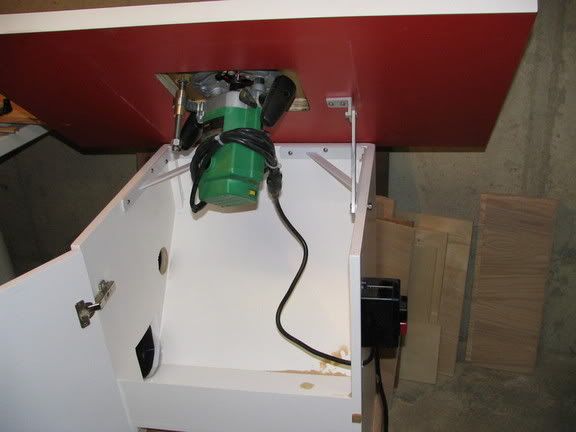Hi all, it seems like a good time for router table questions as there's a few others on the go. As before I'm building an Incra wonder fence, router table and plate and positioner based mobile router table, and seem to be headed for an under table dust collection box. Height adjustment is using a router Raizer, and there's a combined switch and emergency stop unit for control.
Space in the shop is tight, hence the mobile unit. The dust system as many of you know by now is a just installed Pentz based system, so there's lots of puff.
I'd appreciate hearing your views on issues to watch for when configuring this sort of table set up for dust collection. Some that come to mind already are:
1. There's the option to fit a 5in dust connection to under the table (and some recommend this), but there's relatively little by way of open area for the air to be drawn down past the cutter.
Bleed holes are possibly an option, in that it's probably worth getting lots of intake airflow moving in the area of the cutter - but is there a proven solution?
2. The dust connection to the Incra Wonder fence is around 2in dia, which is quite small - and there isn't much opportunity to enlarge it as it's linked to the size of the aluminium extrusion making the fence. Against that it may work pretty well if the tool is well enclosed.
What's the experience in this regard? Hooking it up to a 4in hose (with x4 the cross sectional area) looks risky, it'd drop the air speed in the hose too much for good transportation - but I'd rather not end up messing with a vacuum or the like. It might be more effective to route it back into the under table dust box, and hence back into the larger duct.
3. Mobility is fine, but hanging maybe 8ft of 4in or 5in hose off the back of the router stand isn't all that consistent with this. Especially if hose clips have to be opened and shut every time. Alternatively there's the possibility of leaving the hose connected to the dust system and stashed under the bench in front of the area where the table will be used, and relying on connecting it to the table when needed.
Has anybody got any suggestions for a neat arrangement for this? Preferably one using standard plastic fittings...
4. The under table dust box needs easy access - if only to change the speed setting on the router. (a De Walt DW 625) There's the Incra swing door version, and some straightforward hinged door varieties about.
Are there other designs about that add anything to these?
Thanks,
ian




 Reply With Quote
Reply With Quote








